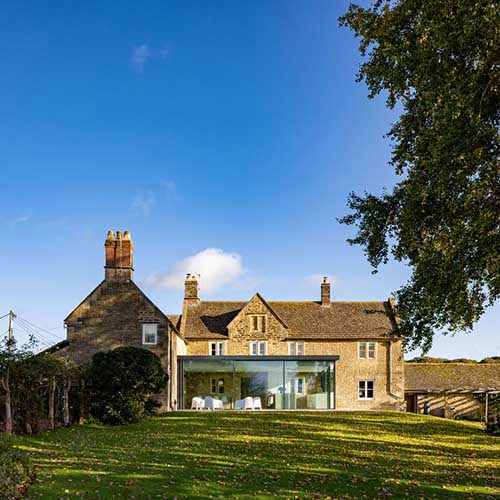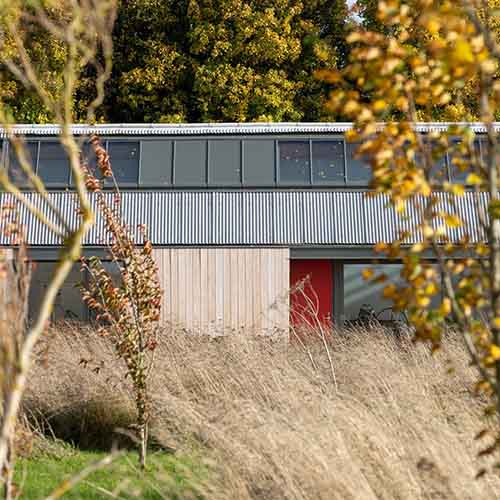Westlands FarmhouseA modern glass extension to a Listed building

Westlands Farmhouse is a contemporary extension to a Listed building, which replaces a 1980s conservatory. The Client had a strong desire to move their kitchen out from the confines of the thick stone walls which define the farmhouse, and out into the daylight. As with most family houses, the kitchen is the heart of all the daytime activity, so having it completely glazed, with 3 out of the five glass panels opening, it becomes a really versatile indoor / outdoor space from which to enjoy the daylight and fresh air of the garden.
The high spec glass door system and heavily insulated roof ensure that the new south facing extension does not overheat or suffer from excessive heat loss.
Quarry WoodExtension providing a new external space for a Modernist house

The existing house was originally a wartime RAF lookout position built into an old stone quarry overlooking Bristol from the Cotswold escarpment on the edge of the Bath. It was converted and extended in the 1970s in a unique design which very much reflected the forward looking client at the time.
The house is “upside down, with the entrance and living rooms all on the upper level, and bedrooms below. The living spaces did not therefore have direct access to any external space except for a large balcony on the (very exposed and windy) North side. The new extension is a sun-facing outside space linked with the living room, with a laundry room and gym below.
The new extension has been constructed from insitu board-marked, waterproof concrete, which allowed for minimal excavation (no working space behind the new wall) and a polished concrete structural slab – no waterproof membrane. The whole structure is insulated from the inside.
Upper FarmAn artist’s studio in South Gloucestershire

The new studio for its artist owner is a replacement for a timber stable building on the edge of a Cotswold village with a typical context of stone buildings with stone tiled roofs. The Client is an artist and printmaker requiring a series of daylit spaces to carry out a variety of wet and dry processes ranging from design to sewing and etching / printing.
The building typology adopted is clearly legible as a simple barn form, appropriate for the setting at the interface between the domestic gardens of the village and the open agricultural landscape. The form also works well for the studio use, with an abundance of controlled daylight from the roof, and inspirational views out over the meadow to the North-west. A single window in the South East facing gable picks out a more focussed view.
The structure is a simple series of expressed portal frames made from LVL timber. The external materials palette continues with the aspiration of simplicity. A fibre cement roof on top of larch boarded walls speak of simple vernacular barns, but with the careful detailing of a less agricultural finish. The glazing is a repetitive module, but with an enlarged section of glazing in the central bay – referencing the barn tradition of a large central opening. An inset entrance door is the only element with a non native material accent colour clearly indicating the entrance.
Internally the Client’s brief called for white surfaces, which is given some relief and a suggestion of materiality by the expressed portal frames. The main volume is semi divided by a series of smaller servant spaces hosting the WC, plant and kitchenette as well as a small fume cupboard room.
The building is heated by an airsource heat pump and underfloor heating within the power floated concrete floor.
Willow LodgeContemporary design in a Cotswold village

Willow lodge is a small cottage built in 1908 and sits on the edge of the picturesque village green in Wiltshire. The property is not listed yet sits within a sensitive rural setting in the Cotswolds Area of Outstanding Natural Beauty. The house had a large and well kept rear garden but it was somewhat remote from the house – separated by a slightly sunken and dark, north facing patio with a cold and inadequate rear extension in it. The Client’s brief was simply to make the most of a challenging site and they were not afraid of a striking and contemporary design in this sensitive location.
Although the extension is on the north side of the house, the orientation of the openings provides south and east as well as north facing glazing and privacy from a rather overbearing neighbour. The east facing glazing provides a miniature courtyard to the east to take advantage of morning sunshine.
The complex form was made by constructing a series of plywood portal frames which were accurately modelled (and optimised structurally) using a parametric Rhino / Grasshopper model, which was then turned into a cutting pattern file for all the elements to be simply cut out using a CNC router. The pieces were numbered and delivered to site, where they were assembled using low tech screw and glue technology. The extension is clad in standing seam zinc cladding, in a manner which compliments the existing house and minimises the building’s whole life embodied carbon footprint.
High tech, low carbon in a Cotswold village

A constrained site, adjacent to a listed building, called for a creative, sensitive and highly contextualised response. The clients were looking for a house that would enhance access to their garden, increase privacy, improve flow through downstairs and provide a downstairs bedroom.
WindrushContemporary Extension in the Cotswolds

This contemporary extension is located to the rear of a quintessential ‘Cotswold’ cottage in a small hamlet on the outskirts of Kemble. The brief called for additional space for the client and their four children. Incorporating the footings of a smaller extension on the same site, the new accommodation comprises a family room, wc and new entrance on the ground floor and two bedrooms and family bathroom on the first floor. A feature glass and timber staircase sits in a glazed transition space between the new extension and original cottage. Designed in accordance with the principles of the Cotswold Design Guide, the horizontal timber boarding render and metal framed windows echo the surrounding agricultural structures.




